Gas pipeline exit from the ground: requirements and features of the arrangement of the exit node
Each stage of connecting a house to a centralized gas pipeline should be carried out in accordance with regulatory documents and installation rules, therefore only representatives of gas services are allowed to work.
Let us dwell on one of the key stages of the equipment - the basement entry. This term designates a monolithic connection of two elements of a gas pipeline: a polyethylene pipe, which is laid in the ground, and a steel pipe, most often an external one.
Gas workers must also select details and equip the gas pipeline from the ground, however, the owner of the house can control the quality of the materials used and the observance of installation standards. And our article will help him in this, in which the normative regulation is examined in detail, schemes and examples of basement input are presented.
The content of the article:
The main guideline is regulatory documentation
In the future, during scheduled inspections or in the event of an emergency, the regulatory authorities will carefully inspect all nodes, starting from center pipe fittings and ending with the connection of a gas boiler, stove or oven. And the first thing they will pay attention to is whether the installation method is selected - aboveground or underground.

The basement entry is an element of the underground gasket, therefore, further we will focus only on it.
But integrity and proper output equipment gas pipe from the ground are important not only because of the risk of getting a large fine during the inspection. The main thing is to ensure the safety of the residents of the house and everyone who is nearby.
Any malfunctioning equipment threatens a serious accident on the gas pipeline. In addition, if the basement is incorrectly designed, gas leakage is possible, and this is an additional expense from the family budget.
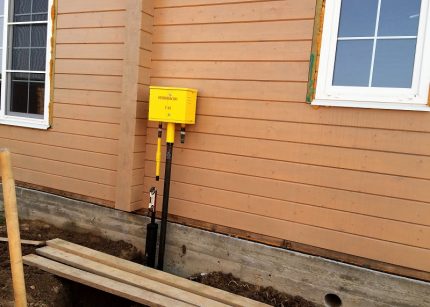
During the laying of the main pipes, the installers are guided by the provisions set forth in the Russian regulatory documents. For example, in SNiP 2.04.08-87 * considered all the nuances of the installation of polyethylene pipes, preferred for private use, as well as requirements for routes of their laying.
The depth of laying the pipeline is also regulated here - 0.8 m. The exception is the territory where traffic is not expected - 0.6 m. These data must be taken into account when choosing the size of equipment for the device to exit the pipeline from the ground, although factory products are usually fitted to standard the scale.
It is undesirable that groundwater is present near the installation site of the input unit. If they do exist, measures must be taken to prevent deformation or ascent of the polyethylene pipe.
Specific information about underground gas pipelines can be obtained from SNiP 42-01-2002. It contains useful materials about the use of cases - special protective elements, as well as the conditions for using polyethylene pipes.
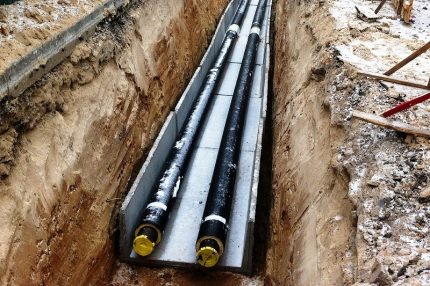
During pipe laying, workers may be faced with the fact that the gas pipeline intersects with other utilities. This is not difficult, since the permissible distance between the networks is only 20 cm.
All stages of construction, from project development to commissioning, must be carried out according to the norms SNiP 3.02.01-87, PB 12-529-03 and SP 62.13330-2011.
Features of gas outlet equipment
It is impossible to independently manufacture parts for equipment for basement
They are produced in the factory from materials that meet the requirements of GOST:
- longitudinal steel pipes (10705-80 or 3262-75);
- seamless pipes (8734-75 or 8732-78);
- polyethylene pipes (50838-95).
It should be remembered that all connections of the introductory part to the gas pipeline must be one-piece - both those that are underground and those that are located outside. Steel elements are joined by welding and insulated. Although low-pressure gas is supplied to the residential sector, the transitional parts are often designed to supply medium or high pressure fuel.
Read more about the pressure in the gas pipeline - read Further.

The length of the lower part depends on the installation and deepening conditions of the gas pipeline. But we must remember that a trench is never laid below the foundation of the house. It turns out that all the details of the entrance of the gas pipeline to the ground should be located on a segment from the bottom point of the foundation to the windows of the 1st floor.
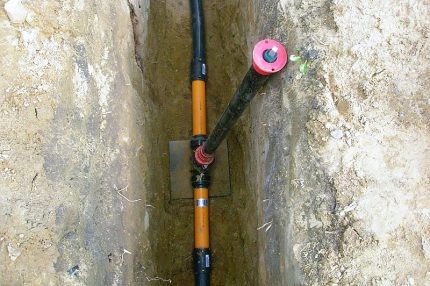
You can ensure the correct temperature regime by warming the polyethylene pipe and one-piece connection. In the southern regions, thermal insulation is not needed, but it is necessary to exclude mechanical stresses on the connection node.
Types of basement inputs
There are three types of nodes for the exit of the gas pipeline from the ground, as well as their options - in the case or without it. All the designs presented are intended for installation in the places where the gas trunk exits from the ground, they are suitable for the gasification of residential buildings, that is, low-pressure networks.
Let us consider in more detail how they differ.
Option # 1 - L-shaped
This is the most common form of construction, having the shape of the letter "G" and resembling a poker. It is usually made of two types of pipes - steel and polyethylene. The steel part is curved by cold bending, without welds, and protected against corrosion by extruded polyethylene or other moisture-resistant material.

The location of the permanent connection underground, on a horizontal site, protects it from freezing in frosts, characteristic of northern regions with a harsh climate.

In addition to conventional designs, products with a transition are produced. This is a metal part of a standard diameter of 25 or 32 mm, made by rolling and fixed by welding.
Option # 2 - i-shaped
The material for the manufacture of i-shaped structures is the same as for the production of L-shaped analogues - polyethylene and steel pipes of GOST standards. They are also intended to ensure the supply of gas to residential buildings - cottages, cottages.
A feature of the products is the location of the polyethylene-steel transition. It is located not on the horizontal part, as in the alternative L-shaped product, but on the vertical, but underground.

To protect the connection, thermal insulation and a metal case are used. i-shaped structures, even the most insulated and insulated, have temperature limitations. They are installed in areas where the air temperature in winter does not fall below -15 ° C.
Low-pressure gas is usually connected to residential buildings, but the i-shaped inlet is suitable for supplying fuel under medium / high pressure.
Option # 3 - Straight
The main difference between the direct exit of the gas pipe from the ground is that it consists entirely of polyethylene, which ensures free bending. The second feature is its use only for the residential sector, as it does not withstand the supply of medium and high pressure fuel.

Direct inputs are located near residential buildings, in the immediate vicinity of the point of connection of household appliances - boilers, stoves, ovens.
Practical example
For a more thorough understanding of the process of introducing gas into the house, we suggest considering an example - gasification of a summer residence.
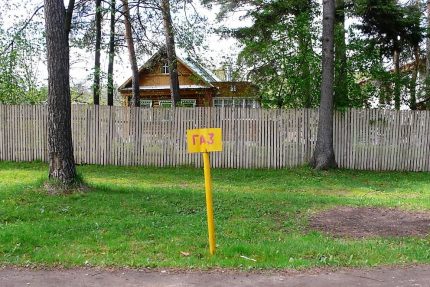
The house is located on a plot with a garden and trees, so when digging a trench I had to “loop” between pine trees and apple trees.
In total, the distance from the tie-in to the central highway to the basement entry is 70 m. The depth of the trench is 1 m, the width is 35-40 cm. This is enough to lay the pipe, and in case of repair, carry out replacement measures.
Further, the highway runs along the wall and is divided into two branches, one of which goes to the gas stove, the second to the domestic heating boiler.
The base entry design from the presented example is a sample of the gas pipeline coming out of the ground in a case, a protective metal case.
There is an article on our site where we examined in detail the process ofazification of a private house. Recommended reading.
What types of cases do they use?
Gas workers themselves determine which type of basement is optimal for specific conditions, they also choose a protective case and how to install it.
Depending on the configuration of the product, it is placed in one of the cases:
- flexible split from polyethylene;
- metal.
Both types are produced in basic conditions.
For the manufacture of an elastic case using a polyethylene pipe cut in half along. During installation, it is glued with sealant, wrapped with adhesive tape along the entire length and clamped with metal clamps.

The metal case is made of steel and mounted on the product during installation of the input to the house. The cavity between the gas pipe and the cover is filled either with spun linen or a rope, and then with both ends ends are clogged with mastic about 20 cm.
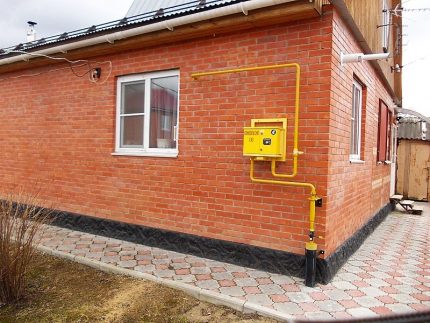
Both types of case should protect the polyethylene-steel transition from external influences as much as possible, as well as ensure the reliability and stability of the structure.
Pipe protection recommendations
Typically, representatives of organizations installing a gas line into the house, act strictly according to the instructions. Any violation of the installation rules is fraught with great trouble for the owners of the house and penalties for gas workers.
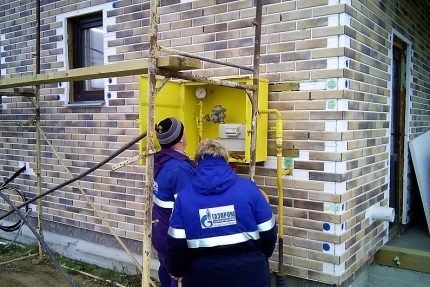
However, sometimes masters also make mistakes, so we recommend the owners of cottages and country houses to closely monitor the work of specialists.
Here are some helpful tips:
- If you know for sure that abyssal soils are characteristic of your territory, require the installation of a basement in the case.
- If there is a risk of flooding with surface water through the backfill soil, then a blind area with a 3-centimeter slope should be built. For structures without a case, the blind area should rise 0.15 m above the ground.
- To protect the structure inside the case, plugs are installed. The top is made mushroom-shaped.
- The caps of the case must have the necessary characteristics of moisture resistance, resistance to UV radiation.
- The vertical part of the input should be perpendicular to the horizontal, without a slope.
- After installation, the case should not sag; if necessary, use special supports.
For backfilling of the input structure, only non-porous soils, sifted and dense, without large inclusions, are suitable. Every 25-30 cm of backfill is carefully rammed to fill the sinuses.
For connecting gas to the house not only ready-made factory basement is used. It joins the internal house line with pipe segments, which often need to be bent.For this, gas specialists always have special equipment and special tools with them.

Typically, workers use their material - quality and tested at other sites, but the owner has the right to request certificates for the materials and check whether they correspond to what is indicated in the project.
Conclusions and useful video on the topic
Overview of the basement entry - inside and out:
Gas entry into the house from the gas tank:
Measures to enter the gas pipeline into the house:
The installation of the basement input is just one of the stages of connecting the house to the highway supplying natural fuel, but you need to take it seriously and responsibly. We recommend concluding an agreement with a service company that will carry out installation, connection, testing, and in the future will monitor the operation of the gas pipeline.
Have questions about the topic of the article? Ask them to our experts - the contact block is located below. You can also supplement the material with valuable information or participate in the discussion.

 Laying a gas pipeline in a case through a wall: the specifics of a device for introducing a pipe for gas into a house
Laying a gas pipeline in a case through a wall: the specifics of a device for introducing a pipe for gas into a house 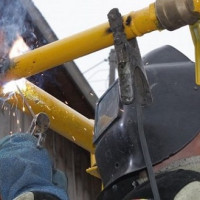 How to crash into a gas pipeline: technical requirements and performance features
How to crash into a gas pipeline: technical requirements and performance features 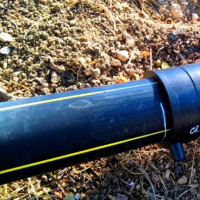 Polyethylene pipes for a gas pipeline: types and specifics of laying pipelines made of polyethylene
Polyethylene pipes for a gas pipeline: types and specifics of laying pipelines made of polyethylene 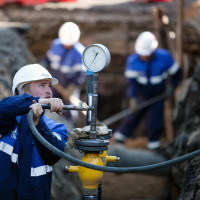 Gas line pressure testing: how are control tightness tests carried out
Gas line pressure testing: how are control tightness tests carried out 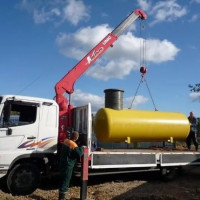 Turnkey gas holder: how to install a gas tank and install equipment
Turnkey gas holder: how to install a gas tank and install equipment 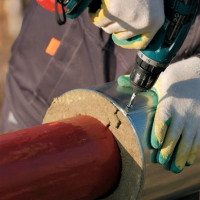 How to insulate a gas pipe on the street from condensation: an overview of the best materials and installation instructions
How to insulate a gas pipe on the street from condensation: an overview of the best materials and installation instructions  How much does it cost to connect gas to a private house: the price of organizing gas supply
How much does it cost to connect gas to a private house: the price of organizing gas supply  The best washing machines with dryer: model rating and customer tips
The best washing machines with dryer: model rating and customer tips  What is the color temperature of light and the nuances of choosing the temperature of the lamps to suit your needs
What is the color temperature of light and the nuances of choosing the temperature of the lamps to suit your needs  Replacement of a geyser in an apartment: replacement paperwork + basic norms and requirements
Replacement of a geyser in an apartment: replacement paperwork + basic norms and requirements